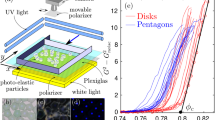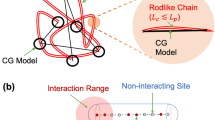Abstract
We perform Monte Carlo simulation of the thermodynamic and structural properties of hard-, square-well, and square-shoulder disks in narrow channels. For the thermodynamics, we study the internal energy per particle and the longitudinal and transverse compressibility factor. For the structure, we study the transverse density and density of pairs profiles, the radial distribution function and longitudinal distribution function, and the (static) longitudinal structure factor. We compare our results with a recent exact semi-analytic solution found by Montero and Santos for the single file formation and first nearest neighbor fluid, and explore how their solution performs when these conditions are not fulfilled making it just an approximation.
Graphical abstract















Similar content being viewed by others
Data availability
This manuscript has no associated data or the data will not be deposited. [Authors’ comment: The data that support the findings of this study are available from the corresponding author upon reasonable request.]
References
R. Fantoni, A. Santos, Multicomponent fluid of nonadditive hard spheres near a wall. Phys. Rev. E 87, 042102 (2013). https://doi.org/10.1103/PhysRevE.87.042102
H. Kyakuno, K. Matsuda, H. Yahiro, Y. Inami, T. Fukuoka, Y. Miyata, K. Yanagi, Y. Maniwa, H. Kataura, T. Saito, M. Yumura, S. Iijima, Confined water inside single-walled carbon nanotubes: global phase diagram and effect of finite length. J. Chem. Phys. 134, 244501 (2011)
M. Majumder, N. Chopra, B.J. Hinds, Mass transport through carbon nanotube membranes in three different regimes: ionic diffusion and gas and liquid flow. ACS Nano 5, 3867 (2011)
D. Boda, W. Nonner, D. Henderson, B. Eisenberg, D. Gillespie, Volume exclusion in calcium selective channels. Biophys. J. 94, 3486 (2008)
R. Fantoni, Exact results for one dimensional fluids through functional integration. J. Stat. Phys. 163, 1247 (2016). https://doi.org/10.1007/s10955-016-1510-3
R. Fantoni, One-dimensional fluids with positive potentials. J. Stat. Phys. 166, 1334 (2017). https://doi.org/10.1007/s10955-016-1707-5
R. Fantoni, How should we choose the boundary conditions in a simulation which could detect anyons in one and two dimensions? J. Low Temp. Phys. 202, 247 (2021). https://doi.org/10.1007/s10909-020-02532-0
A. Santos, R. Fantoni, A. Giacometti, Penetrable square-well fluids: exact results in one dimension. Phys. Rev. E 77, 051206 (2008). https://doi.org/10.1103/PhysRevE.77.051206
R. Fantoni, A. Giacometti, A. Malijevský, A. Santos, A numerical test of a high-penetrability approximation for the one-dimensional penetrable-square-well model. J. Chem. Phys. 133, 024101 (2010). https://doi.org/10.1063/1.3455330
R. Fantoni, Non existence of a phase transition for the penetrable square well model in one dimension. J. Stat. Mech. (2010). https://doi.org/10.1088/1742-5468/2010/07/P07030
M.A.G. Maestre, R. Fantoni, A. Giacometti, A. Santos, Janus fluid with fixed patch orientations: theory and simulations. J. Chem. Phys. 138, 094904 (2013). https://doi.org/10.1063/1.4793626
R. Fantoni, A. Giacometti, M.A.G. Maestre, A. Santos, Phase diagrams of janus fluids with up-down constrained orientations. J. Chem. Phys. 139, 174902 (2013). https://doi.org/10.1063/1.4827861
R. Fantoni, M.A.G. Maestre, A. Santos, Finite-size effects and thermodynamic limit in one-dimensional janus fluids. J. Stat. Mech. (2021). https://doi.org/10.1088/1742-5468/ac2897
R. Fantoni, A. Santos, One-dimensional fluids with second nearest-neighbor interactions. J. Stat. Phys. 169, 1171 (2017). https://doi.org/10.1007/s10955-017-1908-6
A. Santos, A Concise Course on the Theory of Classical Liquids. Basics and Selected Topics, Lecture Notes in Physics, Vol. 923 (Springer, New York, 2016)
L. Tonks, The complete equation of state of one, two and three-dimensional gases of hard elastic spheres. Phys. Rev. 50, 955 (1936)
Z.W. Salsburg, R.W. Zwanzig, J.G. Kirkwood, Molecular distribution functions in a one-dimensional fluid. J. Chem. Phys. 21 ( 1953)
R. Fantoni, B. Jancovici, G. Téllez, Pressures for a one-component plasma on a pseudosphere. J. Stat. Phys. 112, 27 (2003). https://doi.org/10.1023/A:1023671419021
R. Fantoni, G. Téllez, Two dimensional one-component plasma on a flamm’s paraboloid. J. Stat. Phys. 133, 449 (2008). https://doi.org/10.1007/s10955-008-9616-x
R. Fantoni, Two component plasma in a flamm’s paraboloid. J. Stat. Mech. (2012). https://doi.org/10.1088/1742-5468/2012/04/P04015
R. Fantoni, Jellium at finite temperature. Mol. Phys. 120, 4 (2021). https://doi.org/10.1080/00268976.2021.1996648
A.M. Montero, A. Santos, Equation of state of hard-disk fluids under single-file confinement. J. Chem. Phys. 158, 154501 (2023)
A.M. Montero, A. Santos, Structural properties of hard-disk fluids under single-file confinement. J. Chem. Phys. 159, 034503 (2023)
A. Poncet, A. Grabsch, P. Illien, O. Bńichou, Generalized correlation profiles in single-file systems. Phys. Rev. Lett. 127, 220601 (2021)
A. Horner, P. Pohl, Single-file transport of water through membrane channels. Faraday Discuss. 209, 9 (2018)
R. Fantoni, A. Santos, Nonadditive hard-sphere fluid mixtures. A simple analytical theory. Phys. Rev. E 84, 041201 (2011). https://doi.org/10.1103/PhysRevE.84.041201
R. Fantoni, D. Gazzillo, A. Giacometti, Stability boundaries, percolation threshold, and two phase coexistence for polydisperse fluids of adhesive colloidal particles. J. Chem. Phys. 122, 034901 (2005). https://doi.org/10.1063/1.1831275
D. Gazzillo, R. Fantoni, A. Giacometti, Phase behavior of polydisperse sticky hard spheres: analytical solutions and perturbation theory. Mol. Phys. 104, 3451 (2006). https://doi.org/10.1080/00268970601050892
R. Fantoni, D. Gazzillo, A. Giacometti, P. Sollich, Phase behavior of weakly polydisperse sticky hard spheres: perturbation theory for the percus-yevick solution. J. Chem. Phys. 125, 164504 (2006). https://doi.org/10.1063/1.2358136
D.A. Kofke, A.J. Post, Hard particles in narrow pores. Transfer-matrix solution and the periodic narrow box. J. Chem. Phys. 98, 4853 (1993)
K.K. Mon, Analytical evaluation of third and fourth virial coefficients for hard disk fluids in narrow channels and equation of state. Phys. A 556, 124833 (2020)
S. Varga, G. Balló, P. Gurin, Structural properties of hard disks in a narrow tube. J. Stat. Mech. (2011)
A. Huerta, T. Bryk, V.M. Pergamenshchik, A. Trokhymchuk, Collective dynamics in quasi-one-dimensional hard disk system. Front. Phys. 9, 636052 (2021)
M.H. Kalos, P.A. Whitlock, Monte Carlo Methods (Wiley, New York, 1986)
M.P. Allen, D.J. Tildesley, Computer Simulation of Liquids (Oxford University Press, Oxford, 1987). (Section 6.2)
D. Frenkel, B. Smit, Understanding Molecular Simulation (Academic Press, San Diego, 1996)
J.-P. Hansen, I.R. McDonald, Theory of Simple Liquids, 2nd edn. (Academic Press, San Diego, 1986). (Section 2.5)
A.M. Montero, private communication (2023)
V.M. Pergamenshchik, Analytical canonical partition function of a quasi-one-dimensional system of hard disks. J. Chem. Phys. 153, 144111 (2020)
A. Santos, private communication (2023)
Y. Hu, P. Charbonneau, Kosterlitz-thouless-type caging-uncaging transition in a quasi-one-dimensional hard disk system. Phys. Rev. Res. 3, 038001 (2021)
R. Fantoni, D. Gazzillo, A. Giacometti, The thermodynamic instabilities of a binary mixture of sticky hard spheres. Phys. Rev. E 72, 011503 (2005). https://doi.org/10.1103/PhysRevE.72.011503
D. Gazzillo, A. Giacometti, R. Fantoni, P. Sollich, Multicomponent adhesive hard sphere models and short-ranged attractive interactions in colloidal or micellar solutions. Phys. Rev. E 74, 051407 (2006). https://doi.org/10.1103/PhysRevE.74.051407
R. Fantoni, D. Gazzillo, A. Giacometti, M.A. Miller, G. Pastore, Patchy sticky hard spheres: analytical study and Monte Carlo simulations. J. Chem. Phys. 127, 234507 (2007). https://doi.org/10.1063/1.2805066
R. Fantoni, Andersen-weeks-chandler perturbation theory and one-component sticky-hard-spheres. J. Stat. Phys. 168, 652 (2017). https://doi.org/10.1007/s10955-017-1810-2
R. Fantoni, Effect of quantum dispersion on the radial distribution function of a one-component sticky-hard-sphere fluid. J. Stat. Mech. (2018). https://doi.org/10.1088/1742-5468/aab690
Acknowledgements
I am grateful to Ana M. Montero and Andrés Santos for proposing the project, stimulating its publication, and for the very many fruitful discussions and profound insights. I am grateful to Ana M. Montero for providing me with her results used in Figs. 1, 4, 8, 9, 11 some of which had not been published before.
Author information
Authors and Affiliations
Corresponding author
Ethics declarations
Conflict of interest
The author has no conflicts to disclose.
Appendices
Appendix A: On the longitudinal pressure of HD from the LDF
Using the notation of Refs. [22, 23], we have for the Equation Of State (EOS)
where \(A^2\) and \(\phi _i\) are the solutions to
The LDF in the range \(a(\epsilon )<x<2a(\epsilon )\) is
Our aim is to express the EOS in terms of the integrals
Inserting Eq. (A3) into Eq. (A4)
From Eq. (A2), we have \(\sum _{i,j}\phi _i\phi _je^{-\beta p a_{ij}}=\beta p/A^2\). Therefore,
Comparison with Eq. (A1) yields
This is a linear equation in \(Z_\mathrm{{L}}\) which is solved by Eq. (2.13a) in the main text. From which immediately follows that for the pure 1D (Hard Rods) case, we find \(Z_\mathrm{{L}}=1/(1-\lambda )\), since \(\epsilon \rightarrow 0\) and \(a(\epsilon )\rightarrow 1\) so that \(I_n=0\), as it should be [16].
Note also that from Appendix C of Ref. [23] follows that in the \(p\rightarrow \infty \) limit or equivalently in the \(\lambda \rightarrow \lambda _{\textrm{cp}}\) limit one finds \(\lim _{\lambda \rightarrow \lambda _{\textrm{cp}}}\lambda I_0=\lim _{\lambda \rightarrow \lambda _{\textrm{cp}}}\lambda ^2 I_1=1\). In the continuum limit, one has from Eq. (A6a)
In the high-pressure regime
Thus,
By expanding \(a(y+\epsilon /2)\) around \(y=\epsilon /2\)
Therefore,
Consequently
Consistency between this result and Eq. (2.15) gives Eqs. (2.14a)–(2.14b) in the main text.
Appendix B: RDF of the ideal gas in a narrow channel
We arrive at the analytically exact Eq. (3.1) for the RDF of the ideal gas confined in the narrow channel with the following steps
Since the integrand depends only on \(x=|x_2-x_1|\), we have \(\int _0^L\mathrm{{d}}x_1\int _0^L\mathrm{{d}}x_2\ldots =2\int _0^L\mathrm{{d}}x\,(L-x)\ldots \). Moreover,
Therefore,
Where in the first step, we have assumed that \(\sqrt{r^2-(y_2-y_1)^2}<L\) and in the third step we have taken the limit \(L\rightarrow \infty \). In the limit \(r\gg 1\), \(\sqrt{r^2-s^2}\approx r\), so that \(g_{\textrm{id}}(r)\approx 1\) as expected.
The integral in Eq. (B3) can be analytically performed and the result is given by Eq. (3.1) in the main text.
Rights and permissions
Springer Nature or its licensor (e.g. a society or other partner) holds exclusive rights to this article under a publishing agreement with the author(s) or other rightsholder(s); author self-archiving of the accepted manuscript version of this article is solely governed by the terms of such publishing agreement and applicable law.
About this article
Cite this article
Fantoni, R. Monte Carlo simulation of hard-, square-well, and square-shoulder disks in narrow channels. Eur. Phys. J. B 96, 155 (2023). https://doi.org/10.1140/epjb/s10051-023-00625-9
Received:
Accepted:
Published:
DOI: https://doi.org/10.1140/epjb/s10051-023-00625-9




